A recent conversation with Yang Qi about his new installation has touched me profoundly.
The installation titled ‘Church in Assisi, 2021’ is full of artistic energy and mysticism. The material is stone-heavy “stones” cast from expensive, pure paper pulp. It Intentionally expresses a historical and chronological sensation. It wins with a casual, simple form of beauty.Sentimental, melancholic, Christian and pure! Somehow poetic in an ancient architecture from Zen.

The installation has a long history behind its creation. Yang Qi has lectured at the summer art school at Koster Steinfeld for the last 23 years. One day after his teaching, he found this 11-century monastery. It seems to appear from nowhere with towers, temples and architectural styles from Medieval to Renaissance. Since then, the place has been engraved in his soul; its spirit somehow coincides with his artistic mind.


Three years ago, Yang Qi read a book about Medieval Art in Europe and discovered the story of San Francesco d’Assisi. He was deeply touched by the Saint’s kindness, determination and self-realisation. Immediately after completing the book Yang Qi made a painting.

A few months ago, they were lockdown at home in Dusseldorf; his wife Birgit brought some DVD from the library to watch; it happened one film was about San Francesco from Assisi. He told her ‘ This isn’t a simple coincidence; it is the message from God; he is telling me to be compassionate and be a good being.’ So ‘Church in Assisi’ installation was born.
In the installation, each ‘brick’ has the colour of the original pulp. It is the raw material of papermaking from a large German paper mill. It has a gigantic machine that presses paper pulp into big “stones”. Yang Qi has to break each ‘stone’ into unequal pieces, but it’s still so heavy to move into a perfect position. Labouring and long hours into consideration is the press of his work.
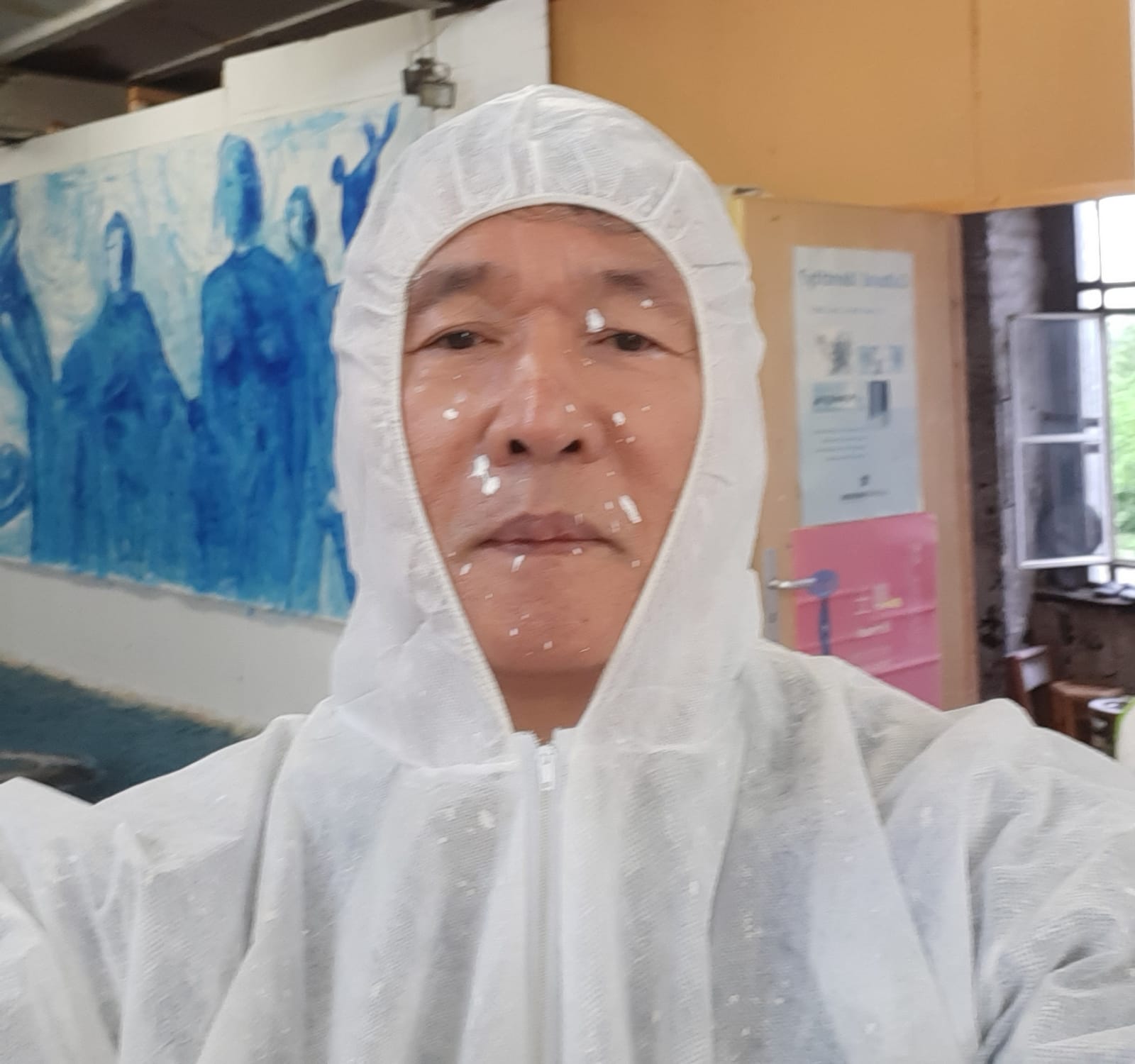
 I felt Iprivileged to share the artist’s spiritual journey of their creation.’Church in Assisi’ is the temple of his art. He offers his devotion, his compassion, enduring on his artistic journey. He shared his answer, ‘What is an artist?’ with the world.
I felt Iprivileged to share the artist’s spiritual journey of their creation.’Church in Assisi’ is the temple of his art. He offers his devotion, his compassion, enduring on his artistic journey. He shared his answer, ‘What is an artist?’ with the world.
Yang Qi’s, who has lived in Dusseldorf for 30 years, originated from Wuhu, China. Recently he has shortlisted for ‘Wolfgang Hahn Preis’ Wolfgang International Contemporary Art Award, Cologne Ludwig Museum, 2021. There are 43 artists nominated for this award, recommended by important institutions of contemporary art in Europe and the US, have been pioneers of art that have been active on the international’s stage for many years. For example Thomas Bayle, Wolfgang Laib, Christian Boltanski, Tracey Emin, William Kentridge, Brigitte Kowanz, Zoe Leonard etc.
Here are some photos from his recent solo exhibition ‘ Here is There’ at Chun Art Museum in Shanghai, 2021. 



Today we would like to share a collection of his large paintings, with the article ‘Dialogue between abstract, figurative and contemporary’ by Beate Reifenscheid, Prof. Dr Director of Ludwig Museum Koblenz.
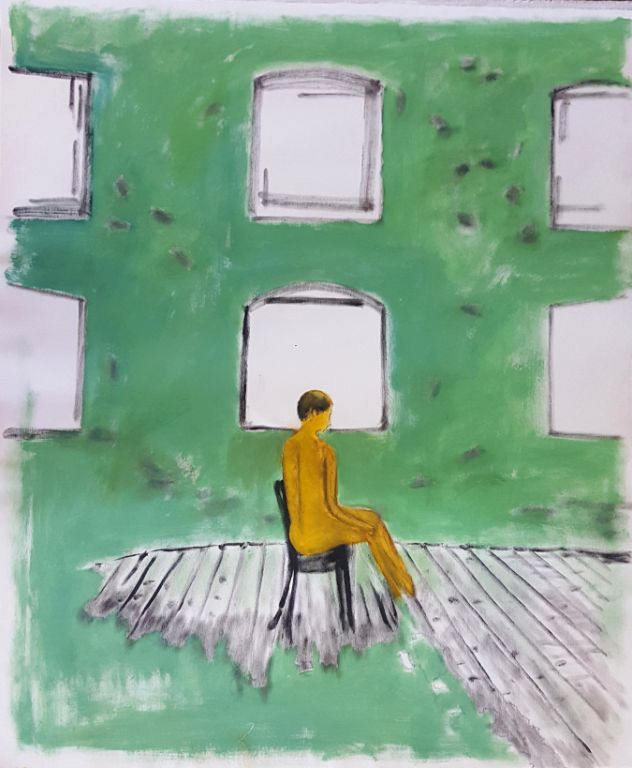 Alone is not lonely 2020, Acrylic-on-canvas, 100cmx80cm
Alone is not lonely 2020, Acrylic-on-canvas, 100cmx80cm
Yang Qi is renowned as an abstract painter in Germany. By the end of the 1990s, the viewers had become familiar with his free brushwork and sharpness, the impasto and rich texture, and retained Chinese culture with the blackest Chinese ink in his painting.
 Get together, 2020 Acrylic on canvas 100cmx80cm
Get together, 2020 Acrylic on canvas 100cmx80cm
From many perspectives, Yang Qi has seriously challenged Chinese brush painting that has dominated Chinese art from ancient times to the present. He uses his brush unrestrainedly, powerfully, exploring extremely concise compositions, fascinated the simplest of forms. If his new language in his painting, can clearly illustrate Chinese spirit and reflect the colour changes in those brush works; then many of his sculpting structures are undoubtedly nurtured. This language works well for his particularly eye-catching large-scale abstract paintings in mixture materials especially. The texture and volume of asphalt surface, vividly express the difference between it and Chinese ink painting. The artistic characteristic is that he can use a mixture of ink and water to paint on thin rice paper and paint with asphalt instead of ink. The texture, especially the rhythm his brush makes in his painting, reminds us of the mixed material painters, the famous German abstract artists Homer and Schumacher. The works reflect their endeavour, the paintings achieved a vivid and lively nature, and embody the perfect abstraction’s figurative expression.
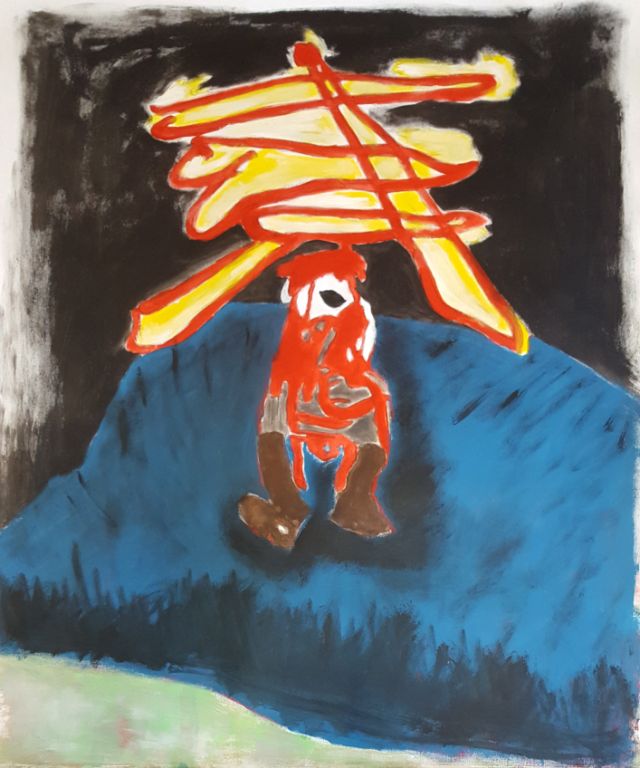 One night story, 2020 Acrylic on canvas 100cmx80cm
One night story, 2020 Acrylic on canvas 100cmx80cm
 Magic boy, 2020 Acrylic on canvas 100cmx80cm
Magic boy, 2020 Acrylic on canvas 100cmx80cm
Homer created his fascinating ‘Aitna – Circular’ Works in the 90s. He incorporated volcanic stones into the sculpture. On the other hand, Schumacher used big fast asphalt fragments and sand to mix abstract and real natural materials. They clearly stated that the creative power of nature and its auxiliary materials appearing in the paintings, while also reflecting the abstract painting language of nature itself. It is sufficient to prove that abstract forms are equivalent to the most realistic and concrete. The witness of existence is real. The painting language related to abstract painting is inseparable from its current object conditions; otherwise, it will be greatly distorted in recognition. Because abstract painting emphasises getting rid of the set concrete form. This also applies to a natural and realistic mindset. 1992 Nian Emil – Schumacher wrote his own profound feeling: ‘In fact, painting is always a process of changing form. I have a dialectical view. Break and stand. In this sense, I want to let them explain some paintings. Therefore, I often try to break the picture.’
 The artist as Hermit 2004-19 oil and acryl on canvas 160 cm x 120 cm
The artist as Hermit 2004-19 oil and acryl on canvas 160 cm x 120 cm
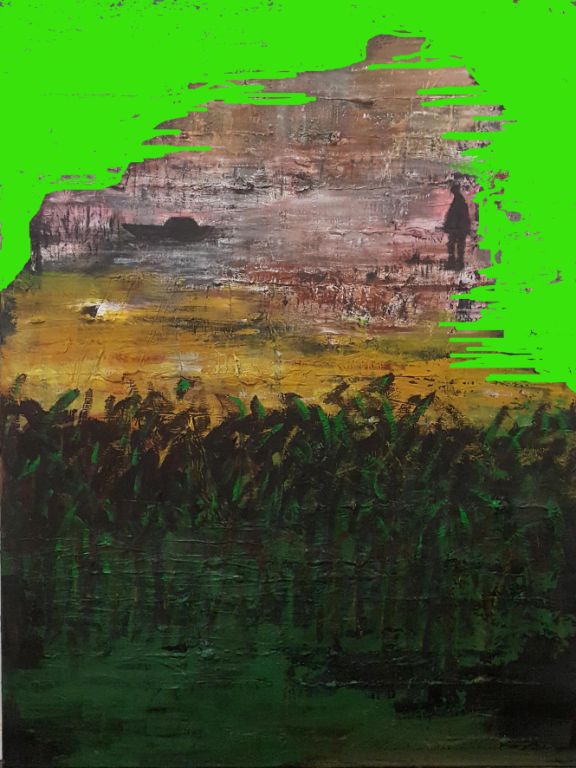 The artist as Hermit 2004-19 oil and acryl on canvas 160 cm x 120 cm
The artist as Hermit 2004-19 oil and acryl on canvas 160 cm x 120 cm
In recent years, Yang Qi’s works have become more intriguing. He has constantly challenged two painting concepts. This is actually in line with the law of contradiction and harmony. For example, the Chinese ink painting developed from Chinese calligraphy is already very abstract. It was not only influenced by Zen Buddhism but also inspired European artists after World War II. Also, in Chinese ink painting and “The “non-figurative” painting produced a direct response. In his second vision, Yang Qi broadened China and Europe’s artistic concepts and questioned abstraction and figurative. Therefore, his easel painting combined the use of comprehensive materials. Although he drew lessons from Homer and Schumacher, he devoted himself to image painting and was close to the real-life world. Emil Schumacher realised that his paintings could not remain abstract in the long run. So he turned to the image. He was using extremely refined lines to determine the picture. He once said in 1997, “Colour has created a world of mine, but she needs image support. I paint, I combine, and I integrate it all into one. ”
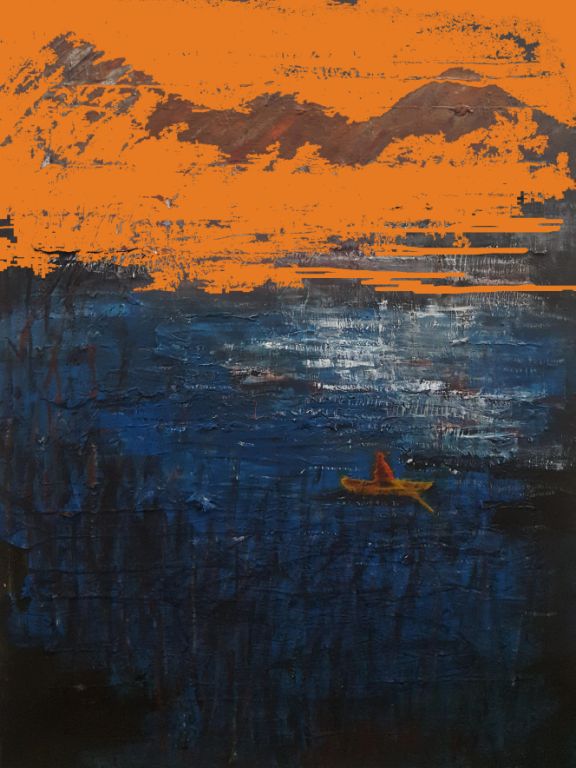 The artist as Hermit 2004-19 oil and acryl on canvas 160 cm x 120 cm
The artist as Hermit 2004-19 oil and acryl on canvas 160 cm x 120 cm
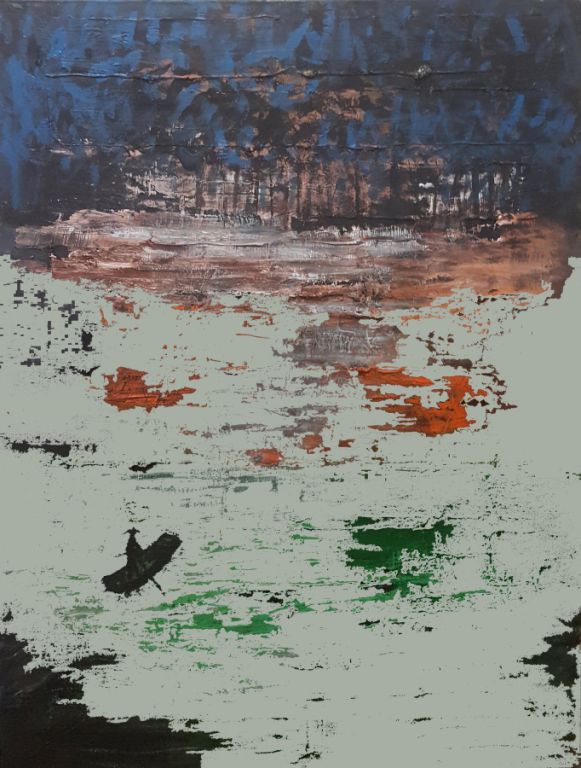 The artist as Hermit 2004-19 oil and acryl on canvas 160 cm x 120 cm
The artist as Hermit 2004-19 oil and acryl on canvas 160 cm x 120 cm
For more than 20 years, Yang Qi has always used various possible expression techniques to inject figures into his paintings. These are clearly reflected in his photographic works, installation art, video works, ceramics, and ink paintings, especially in his easel paintings. Interestingly, these works of his characters still have a more or less abstract feeling to the audience. The audience can tell at a glance that, like the past works, they are a bridge between two cultures. Yang Qi has maintained the particularity of his own cultural model for a long time, and at the same time incorporates elements of Western culture into his art. Obviously, without Yang Qi’s profound foundation in Chinese tradition, his large-scale ink paintings would not have reached such a high level in the past five years. He has mastered the picture’s spatial layout, the exciting plot, including a unique combing of the overall picture. He is unassuming and lives quietly in a profound connection that is more meaningful than Chinese culture. Don’t deliberately insist on what you must win. His expansive free images directly hit the audience, and even the audience often involuntarily enters the plot in his paintings. The plot in his painting comes directly from the centre of his life. The narration of his pictures transcends national boundaries and maintains the cultural origins of various nationalities. Each story has its own history. Some are even personal experiences, but he does not make special statements.
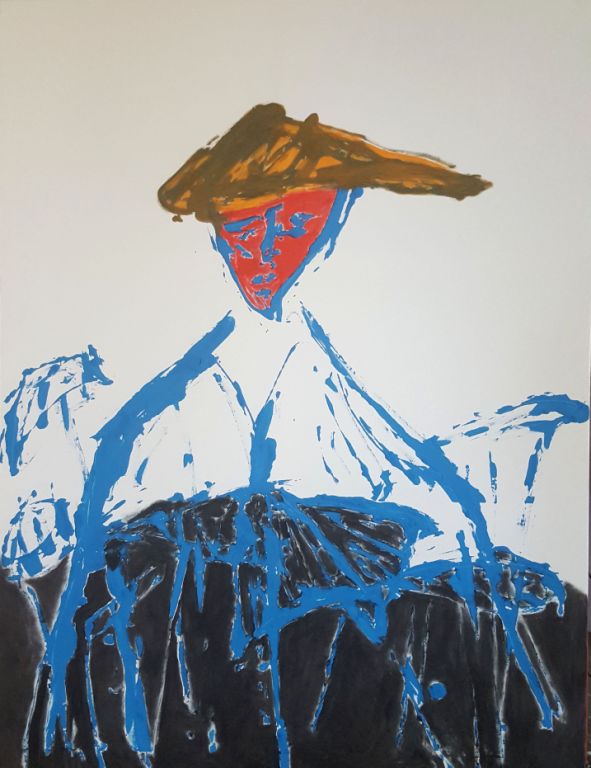 A man with lotus, 2018 Acrylic on canvas 210cmx160cm
A man with lotus, 2018 Acrylic on canvas 210cmx160cm
 Together, 2020 Acrylic on canvas 100cmx80cm
Together, 2020 Acrylic on canvas 100cmx80cm
Yang Qi is good at occupying the whole canvas with a single figure. Eliminate trivial descriptions. From this, it reminds me of the narrative of the plot in a surrealist painting. The compositions of his paintings are specific plots and images that are related to the context. That allows the audience to use their imagination freely.
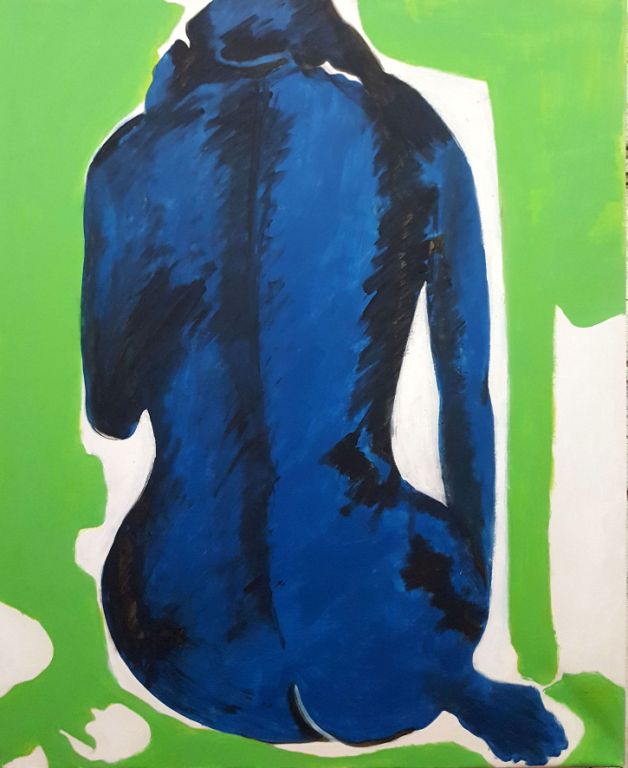 Angelika, 2019 Acrylic on canvas 120cmx100cm
Angelika, 2019 Acrylic on canvas 120cmx100cm
Yang Qi’s easel paintings developed the tradition of the layout. What he is concerned about is how to express the theme. Each painting focuses on the figures and then makes an individual’s artistic description according to their behaviours. Yang Qi uses extremely simple or agitated lines to outline objects. Unlike his ink painting, the figures on the canvas are usually in a specific theme. It expresses a fixed, unchangeable, independent character painting without extra space. Yang Qi’s colour method is also consistent with this form of expression. Thinking back to how Yang Qi succeeded in painting with abstract materials and integrated materials, people will naturally understand how his experience of using materials has given new life to these new works. He used the abstract techniques developed since his 90s to express the realistic figures in his new works uniquely. The narrative festival updated the artistic expression of ancient Chinese painting.
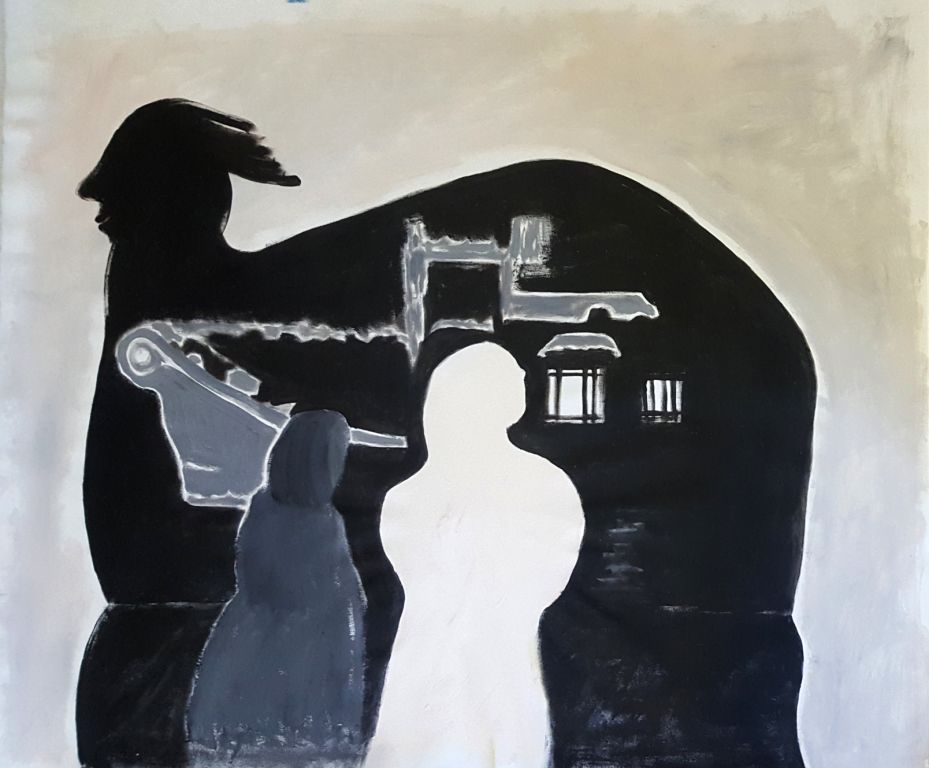 Theater, 2020 Acrylic on canvas 100cmx80cm.
Theater, 2020 Acrylic on canvas 100cmx80cm.
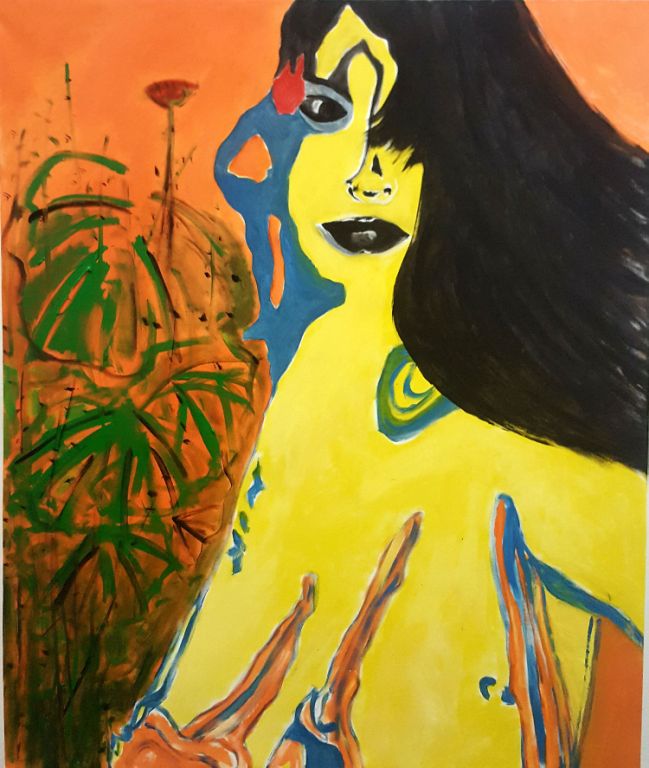 Monika, 2019 Acrylic on canvas 120cmx100cm
Monika, 2019 Acrylic on canvas 120cmx100cm
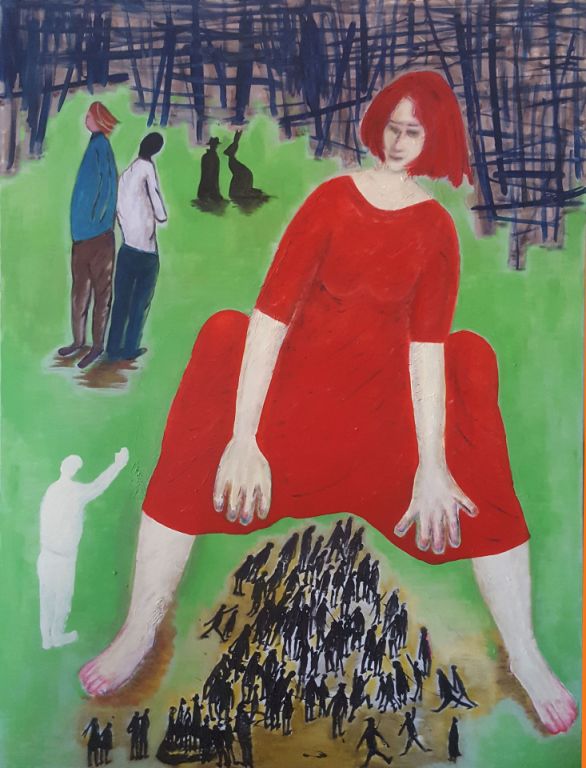 Venus and her friends, 2018 Acrylic on canvas 210cmx160cm
Venus and her friends, 2018 Acrylic on canvas 210cmx160cm
Yang Qi’s painting art has three decisive themes: figure painting (portraits, and other styles), landscape (mountain, water), and animals (especially birds). For Yang Qi, these all belong to his special category of figure painting and object painting. He always observes and watches them in his life. This will help the audience understand the art and character composition of Yang Qi’s paintings. At least the audience can find themselves to explain Yang Qi’s paintings. Simultaneously, he expanded the spatial distance through close-ups of the pictures’ Colour and texture, highlighting the difference between the real world and the other art world. The characters in Yang Qi’s paintings live vividly in his traditional Chinese painting environment.
 Illusion 2018 Acrylic on canvas 210cmx160cm
Illusion 2018 Acrylic on canvas 210cmx160cm
 Where you are from, 2020 Acrylic on canvas 100cmx80cm.
Where you are from, 2020 Acrylic on canvas 100cmx80cm.
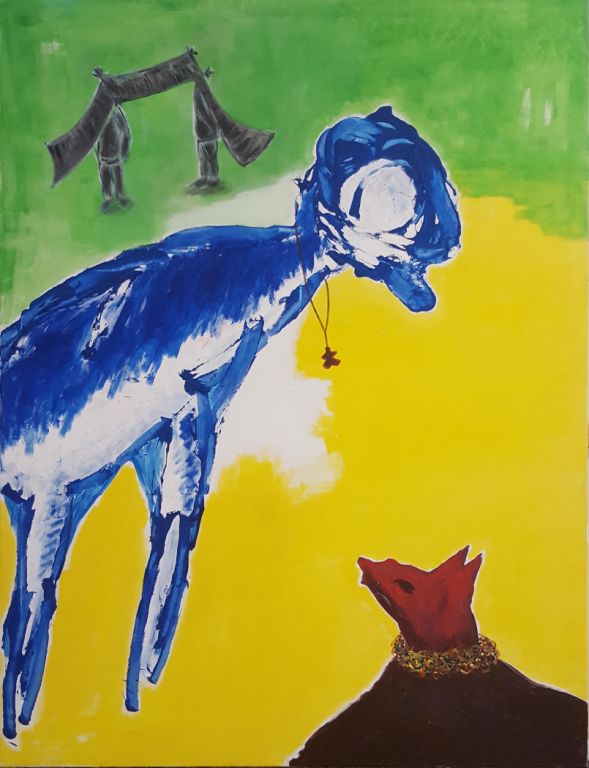 A friend Indeed, 2018 Acrylic on canvas 210cmx160cm.
A friend Indeed, 2018 Acrylic on canvas 210cmx160cm.
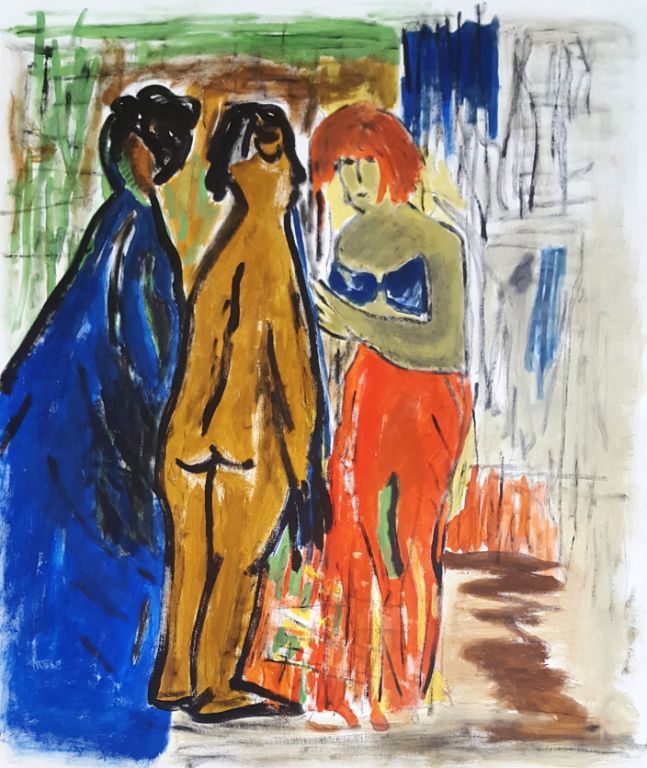 We love art, 2020 Acrylic on canvas 100cmx80cm.
We love art, 2020 Acrylic on canvas 100cmx80cm.

Yang Qi’s CV
For any enquiries, please email: info@artchinauk.com
Conversation with Yang Qi is always inspiring and fills you with joyful laughter. He got this great sense of humour and endless passion, qualities that also make their way into his art which poignantly depicts the spirit of the contemporary experience. His recent large painting titled “Sleepless” is a great example of this.
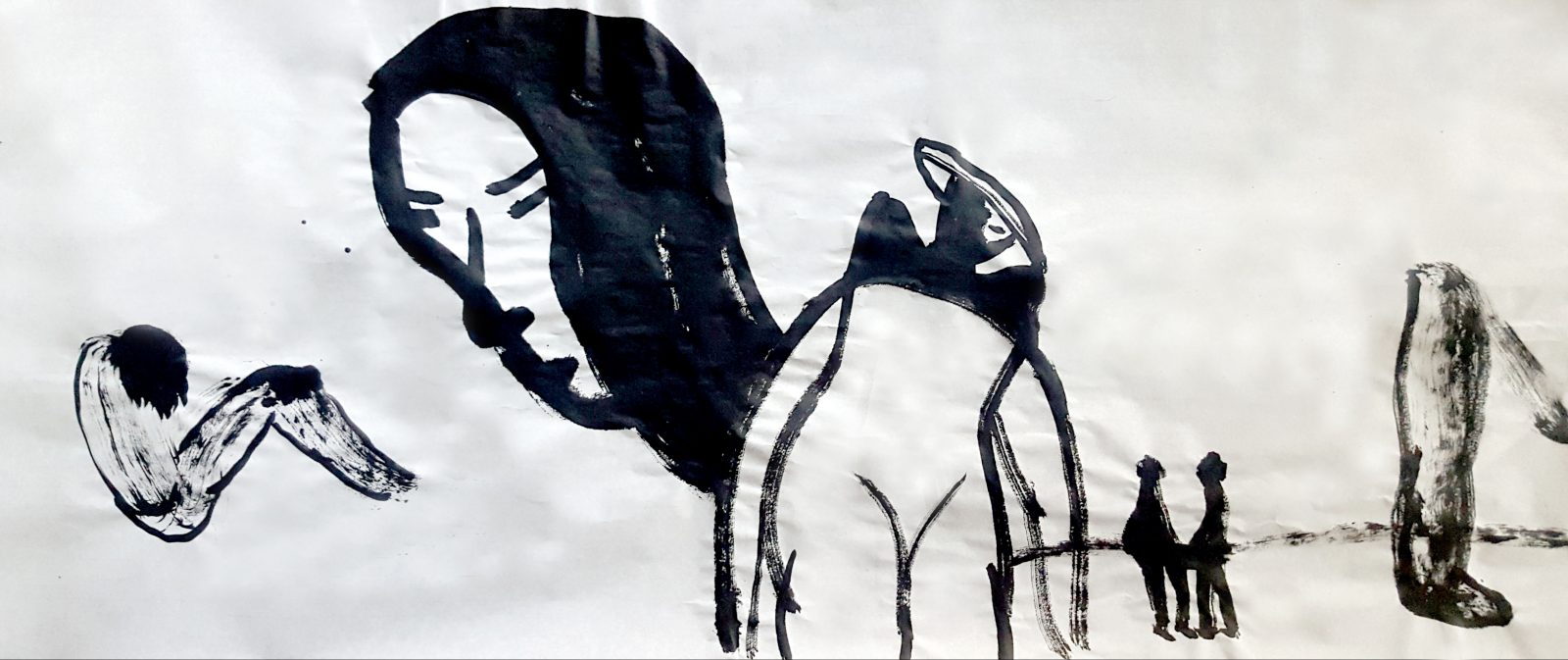
Yang Qi, lives in Dusseldorf. He started painting “Sleepless” at the beginning of the German lockdown and for 2 months he painted through the whole of every night, thus creating a 70m x 50cm Neo-expressionist painting that is dominated by only two colours: Black and White.
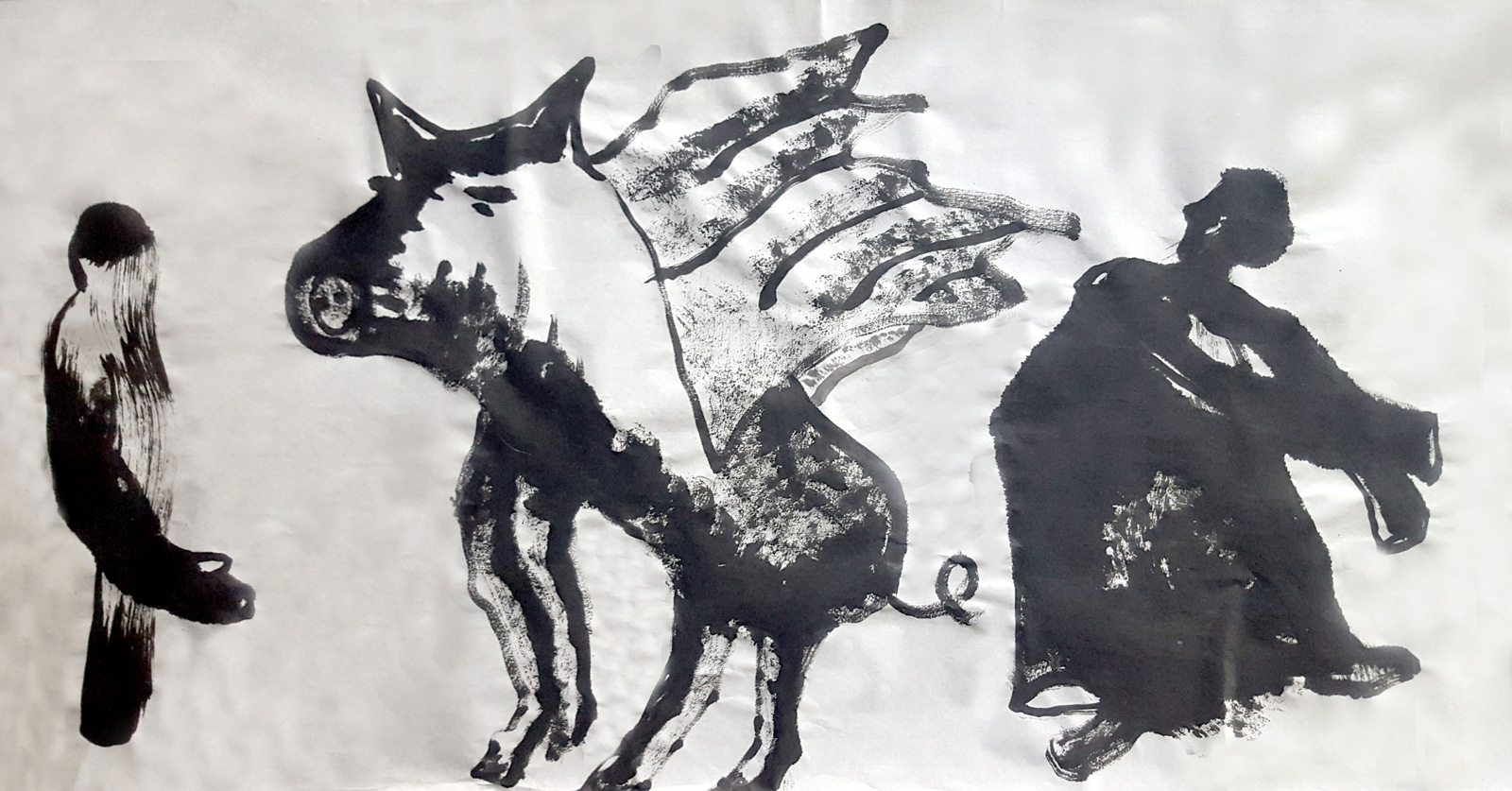
This is an absurd and surrealistic painting process, and it reveals Yang’s inner psychological activities during those nights. By only applying black and white colours he expresses the intensity and originality of his emotions, and coincidentally the contrasts that this creates also fit in well with Yang’s background, as an Eastern artist lives in the Western world for the last thirty years.
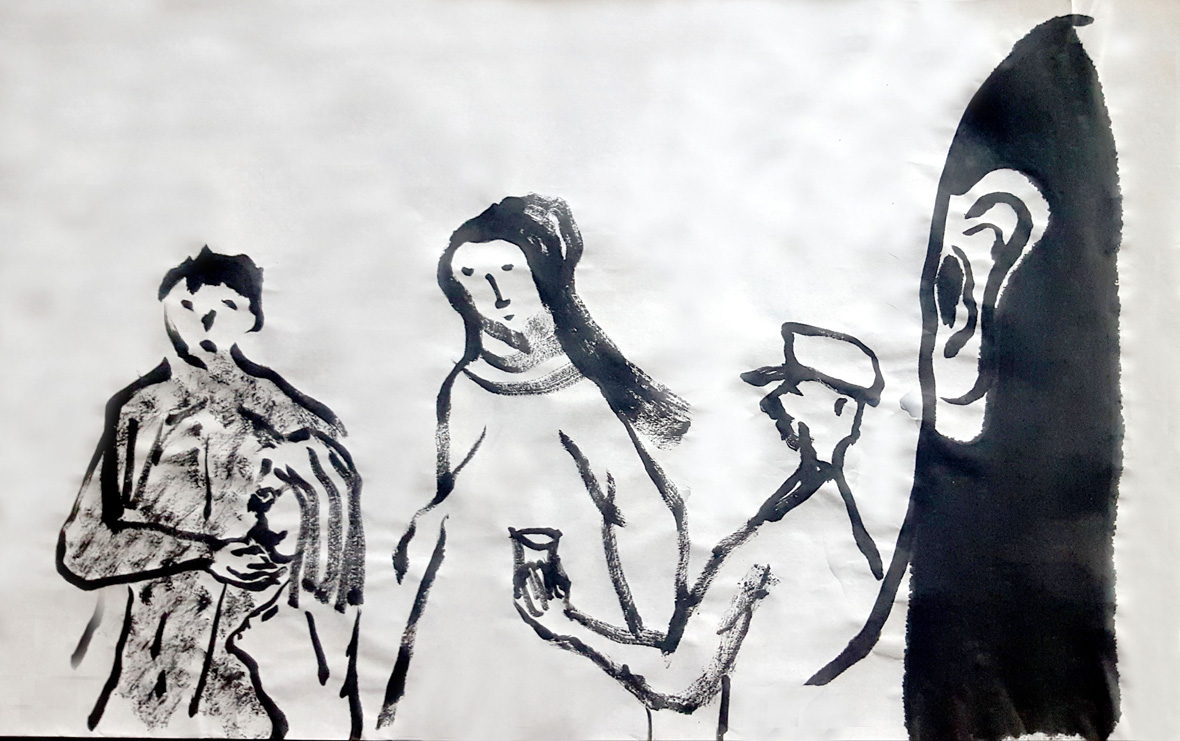
The painting is a labour of love, absurd, suspicious, unknowing, inspiring and dream-like, bringing us into a surreal world. During the Covid-19 pandemic we have seen so many people and countries that are in a state of isolation, even panic, and many people rightly feel nervous. In this kind of collective depression, as an artist, Yang Qi transcends the state of reality by engaging in a very interesting activity, which is a psychological activity of the artist himself, an activity which is confined to his own world, but also an activity that is art. By his nightly creations he has jumped out of our collective reality and when studying the painting you have to look at the world and what is happening through his mind, which he himself has fully immersed himself in. His mind is like the state of a game, so are his characters, his surrounding, his depictions, his performance, and they are all different from those of a realist. In his painting Yang Qi has expressed himself absolutely and unreservedly, his own unconscious activities, and through his subjective force, it can resist the current external interferences and disturbances.

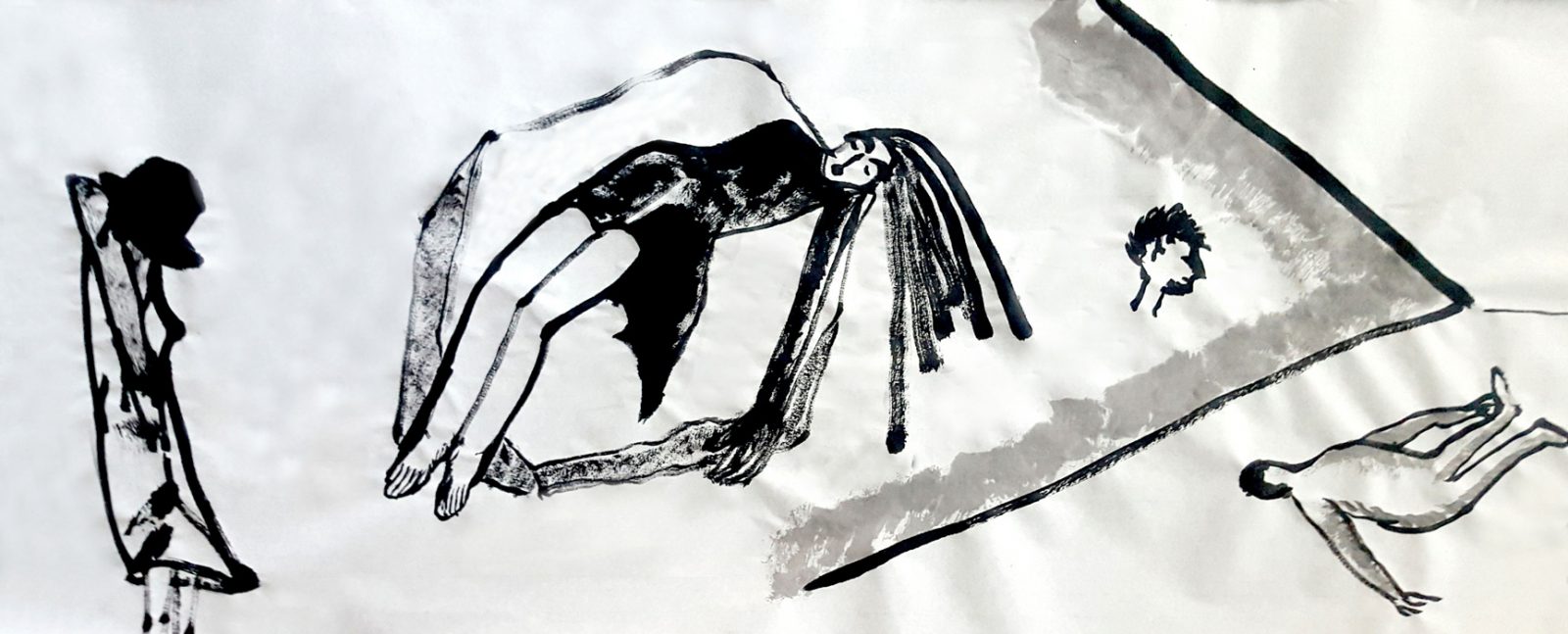

Read about more about Yang Qi.
杨起艺术生涯自述
YANG QI’S BIOGRAPHY OF ART LIFE
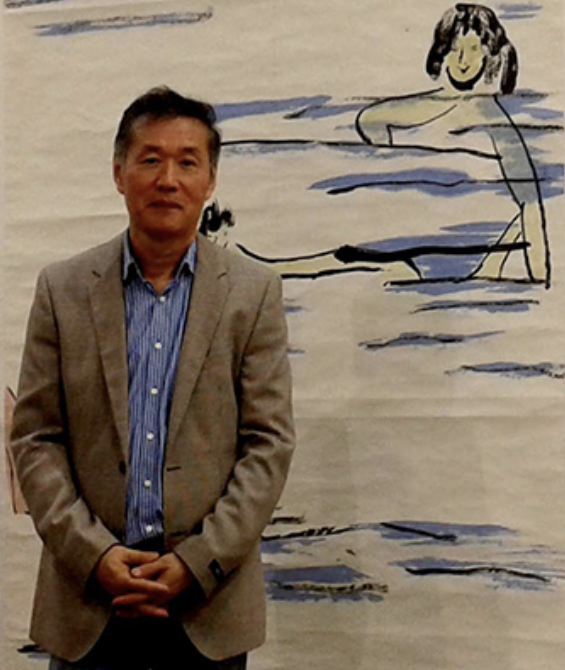
我出生在一个艺术氛围浓郁的家庭,我父亲于二十世纪三十年代末毕业于当今中国最高艺术学府“中国美术学院”的前身之一“苏州艺术专科学校”, “苏州艺术专科学校“是由中国现代著名画家,美术教育家颜文梁先生和当时留学法国的部分中国艺术家于二十世纪三十年代在苏州创办和主持的;随后我父亲继续在国画大师徐悲鸿主教的”中央大学“艺术系继续深造,通过不断地磨练和积累很快即成为当时中国南方颇有影响的画家和艺术理论教授。我母亲出生于德国的法兰克福,外祖父和外祖母皆是早年在德国求学的学子,取得博士学位后留在了当地行医,因此我从小也接收了部分西洋文化的教育。
I was born in an artist’s family. My father graduated, around the end of 1930s, from Suzhou Art Institute, one of the predecessor institutes that constituted the unsurpassed China Academy of Art today. Suzhou Art Institute was established in the 1930s by Mr. Yan Wenliang, a great modern painting master and educator, together with a group of Chinese artists who studied in French. Later, my father continued his study in the art department of Central University under Chinese painting master Xu Beihong’s education. After a long period of training and studying, my father soon became an influential artist and art professor in southern China. My mother was born in Frankfurt, Germany; my grandparents went to Germany at a young age to study. They lived there as doctors after getting their PhDs. So I also attained a bit of Western education as a child.
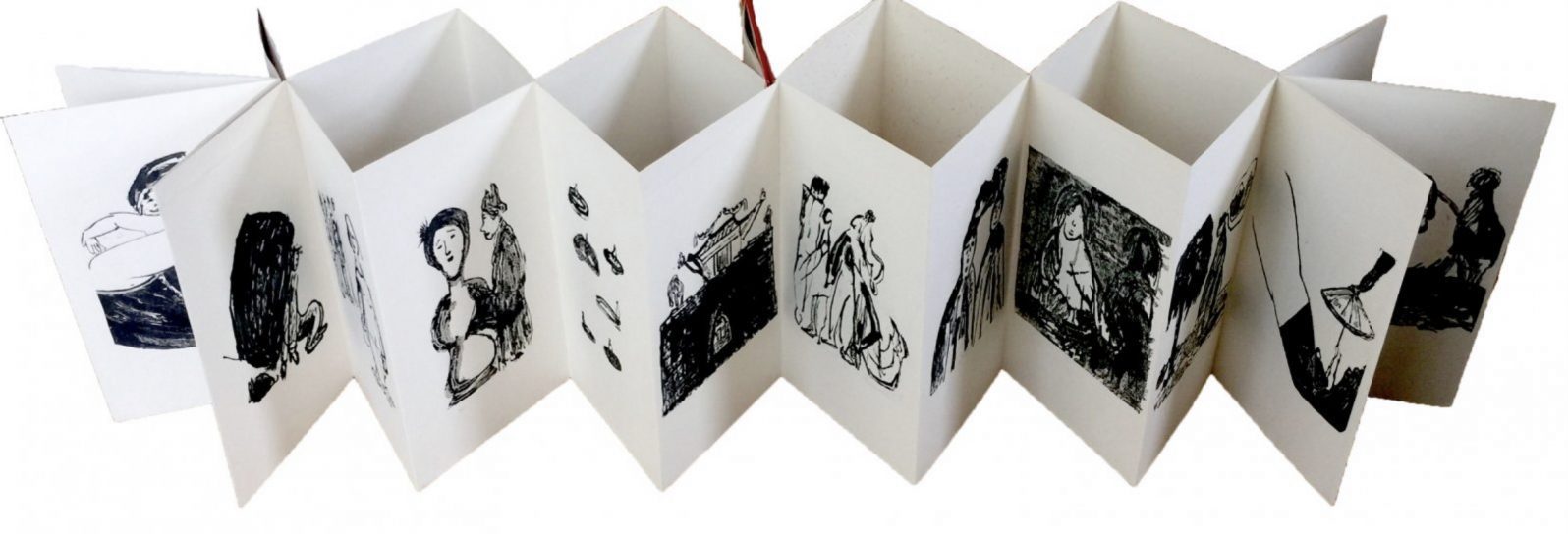
我儿时的记忆中每当父亲作画时我和我哥哥、弟弟经常都会在一旁饶有兴趣的看着,或者我们兄弟三人也会学着父亲的样子拿出纸和笔信手涂鸦,我父亲也就时常给我们一些简单的指导,同时还给我们讲一些中国传统诗文和外国的艺术故事,在这种看似无心的潜移默化过程中,我最早的绘画情趣得以培养,印象中从我的孩提时代一直到青少年时代都是跟父亲在一起画,而且学习素描、雕塑、绘画都是自然而然的同时发展起来的,很显然我父亲就是我的艺术启蒙 老师。
In my early memories, in great interest, my brothers and I often watched my father painting. Sometimes we also made casual drawings mimicking our father’s work. He often gave us some lessons, telling us stories of traditional Chinese poetry and foreign arts. Unconsciously influenced by this creative atmosphere, my original interest in painting developed. I spent my childhood and teenage years painting with my father, discovering initially how to sketch, sculpt and paint spontaneously around the same period. Apparently, my father was my first teacher of the arts.

对我产生过影响的艺术家在不同时期有好几位,几乎都是国外的艺术家,中国的艺术家里面只有一个,那就是中国现代画家,散文家,美术教育家丰子恺。小的时候我们经常在我父亲那受到一些影响,也看过的丰子恺的一些中国抗战时期的书本插图,画了一些非常有人情味的生活的一些场景,一些绘画还配有诗文,记忆非常深刻。国外艺术家比较早的有毕加索,夏加尔。尤其我来的欧洲以后,首先是德国的表现主义一直到现在的新表现主义对我影响巨大,使我从一个中国的艺术家来到德国以后最后变成德国的新表现主义的艺术家代表人物之一,这是一个非常重要的过程。
I was influenced by different artists during different times, most of whom were Western artists. The one and only Chinese artist who influenced me greatly was Feng Zikai, a famous modern painter, prose writer and art educator. Influenced by my father during childhood, I have also seen many paintings in Feng Zikai’s books created during the War of Resistance Against Japan. Those empathetic images of life scenes, and the poems written with the paintings, rooted themselves deeply in my mind for a long time. Foreign artists such as Picasso and Chagall influenced me significantly; living in Europe, German expressionism and later neo-expressionism both transformed me from a Chinese artist into a representative figure of German neo-expressionism, which has been an important process for my art.
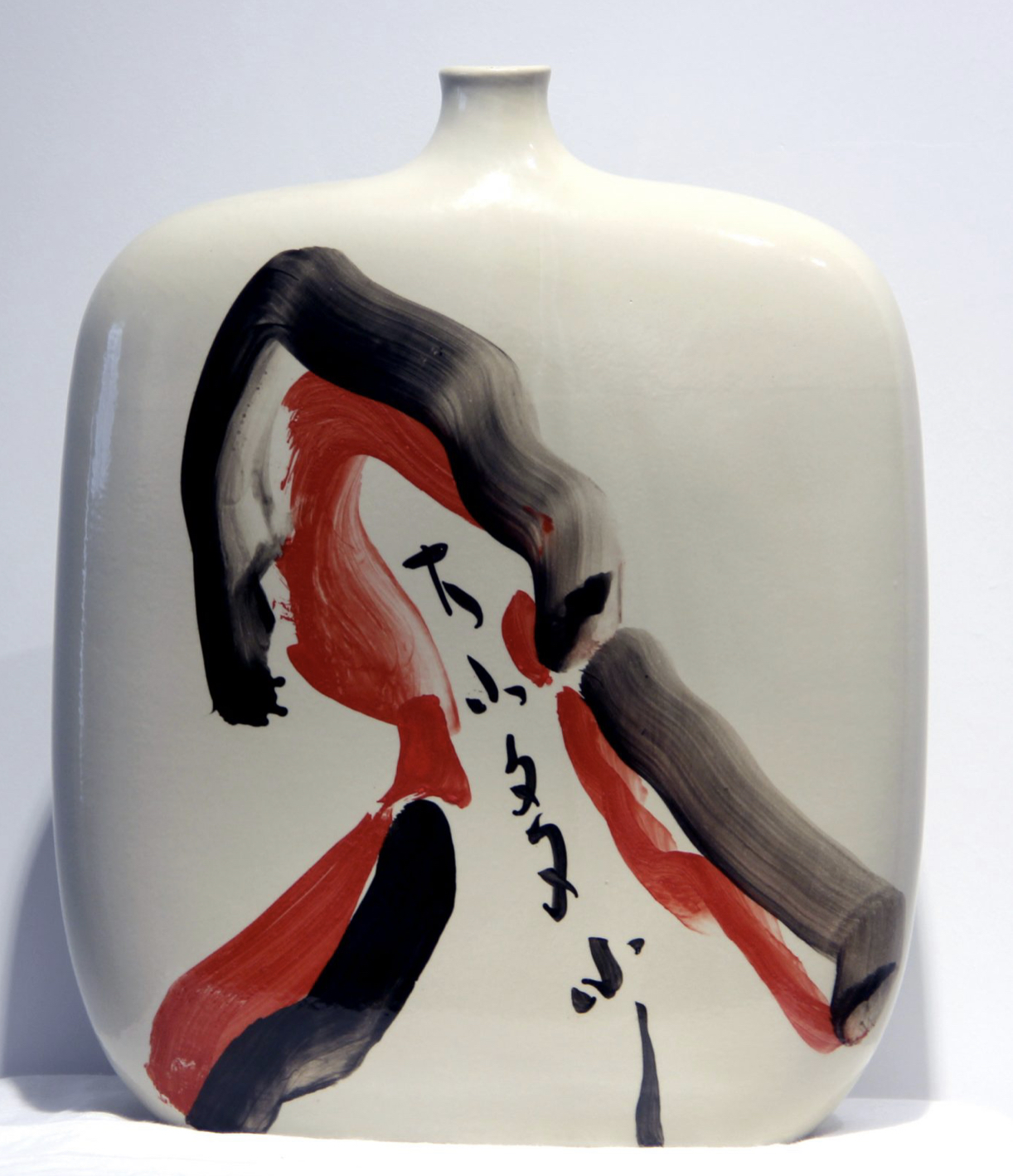
我的装置很大程度上都是来自于哲学,中国和德国的哲学。比方说中国的道家的哲学和德国的哲学家海德格对我的影响很大,还有艺术上面就是德国的Joseph Beuys。在我刚到德国来的时候,我对他的作品非常感兴趣。
My work, to a large extent, is based on Chinese and German philosophies, such as Taoism, as well as Heidegger’s theories. In terms of arts, German artist Joseph Beuys raised my interest greatly when I first came to Germany.
我不大喜欢波普艺术,我是比较钻牛角间的。对学术性的艺术我是非常感兴趣,我本人一直投身于学术艺术方面的一些创造和发展。
I don’t favour pop art much as I am more into academic art. I have spent a long time developing and creating art with an academic focus.

在个人生活中哪些发生过事情对我的创作影响很大,第一件重要事情就是我走出了国门来到了德国,看到了一些我曾经在艺术杂志上见过的一些非常宏伟的作品。从古典主义,从文艺复兴以前,从中世纪一直到现当代的艺术作品,很多大师的原著我都如饥似渴的去看,去注意研究和对比,因为我一直想我能够超越他们吗?同时也看到了很多欧洲美术馆这大量艺术家的原作,包括我不曾了解的一些艺术家。
There are a few things in life that have influenced my art. The first thing was coming to Germany to see great masterpieces in person that I had previously seen in magazines. From classicism to renaissance, from medieval arts to modern and contemporary ages, I ventured among as many masterpieces as I could. With a great dedication of time and interest, I studied and compared their works, contemplating how my own art could reach and exceed their accomplishments. I also have seen many original artworks by European artists in galleries, including some artists I didn’t know.
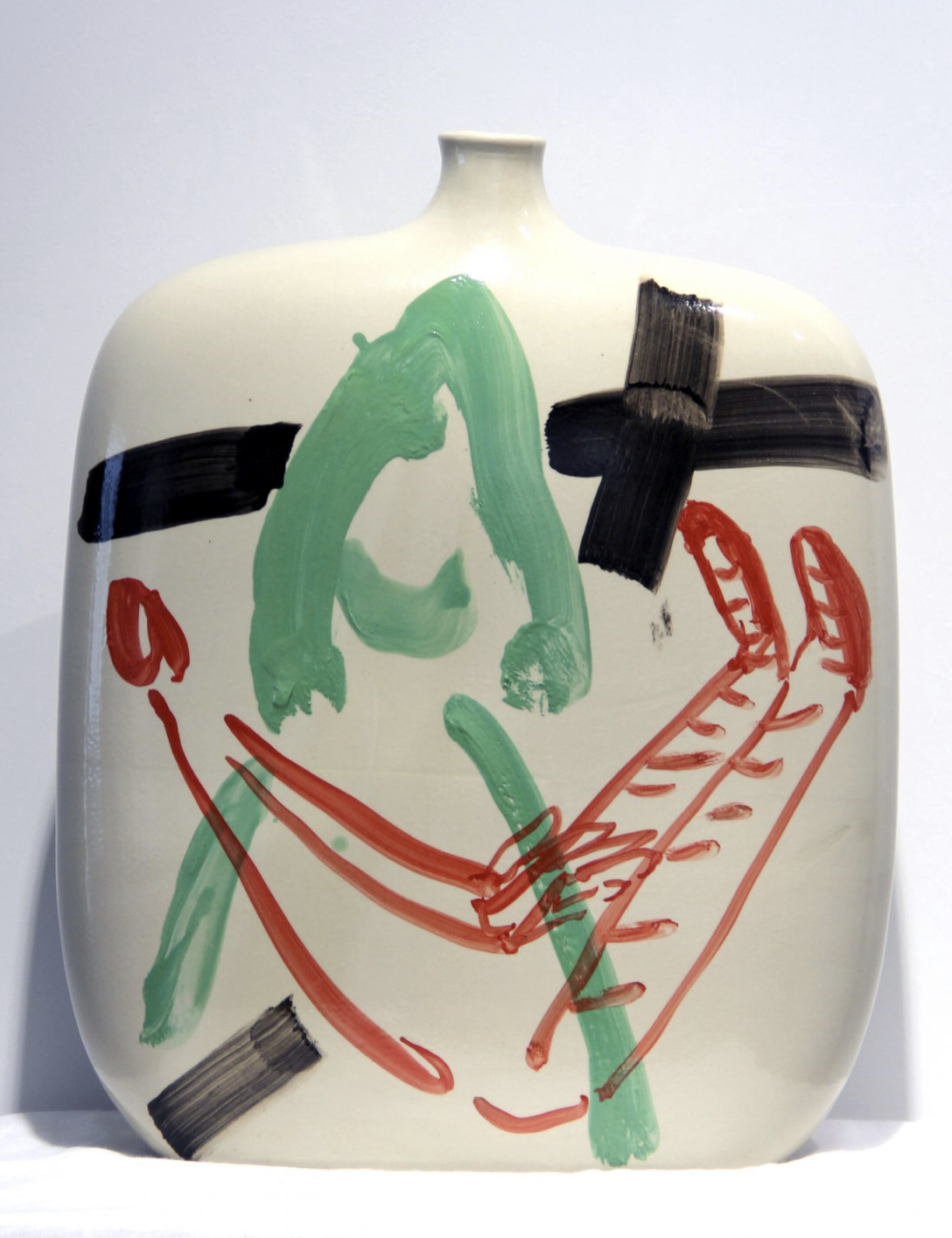
这个过程是个非常重要的转折点,我一直在思考:如果这个世界上已经有这么多人画过这么多画的话,那么我如果再继续的画,我就不能够再和他们一样的画,我就要搞出自己的东西。所以整个一个人从中国到了德国从东方来到西方,这个艺术观念的转变是在设身处地的环境中才能产生的。在欧洲在西方,特别是在德国这个当代艺术发展的特别旺盛和迅猛的一个时期,那个时期是从八十年代末到九十年代对我来说非常重要。
The above experience was an important transformational point in the way I think about the arts: there have been so many people in the world creating different artworks that I should continue my path creating something different from existing forms; I should create something of my own. Moving from China to Germany, from an Eastern world to the West meant my entire artistic insight has transformed within a complete change of environment. In the West, especially in Germany during the late 80s and 90s which was its rapid flourishing period of contemporary art, I attained great knowledge of the arts.
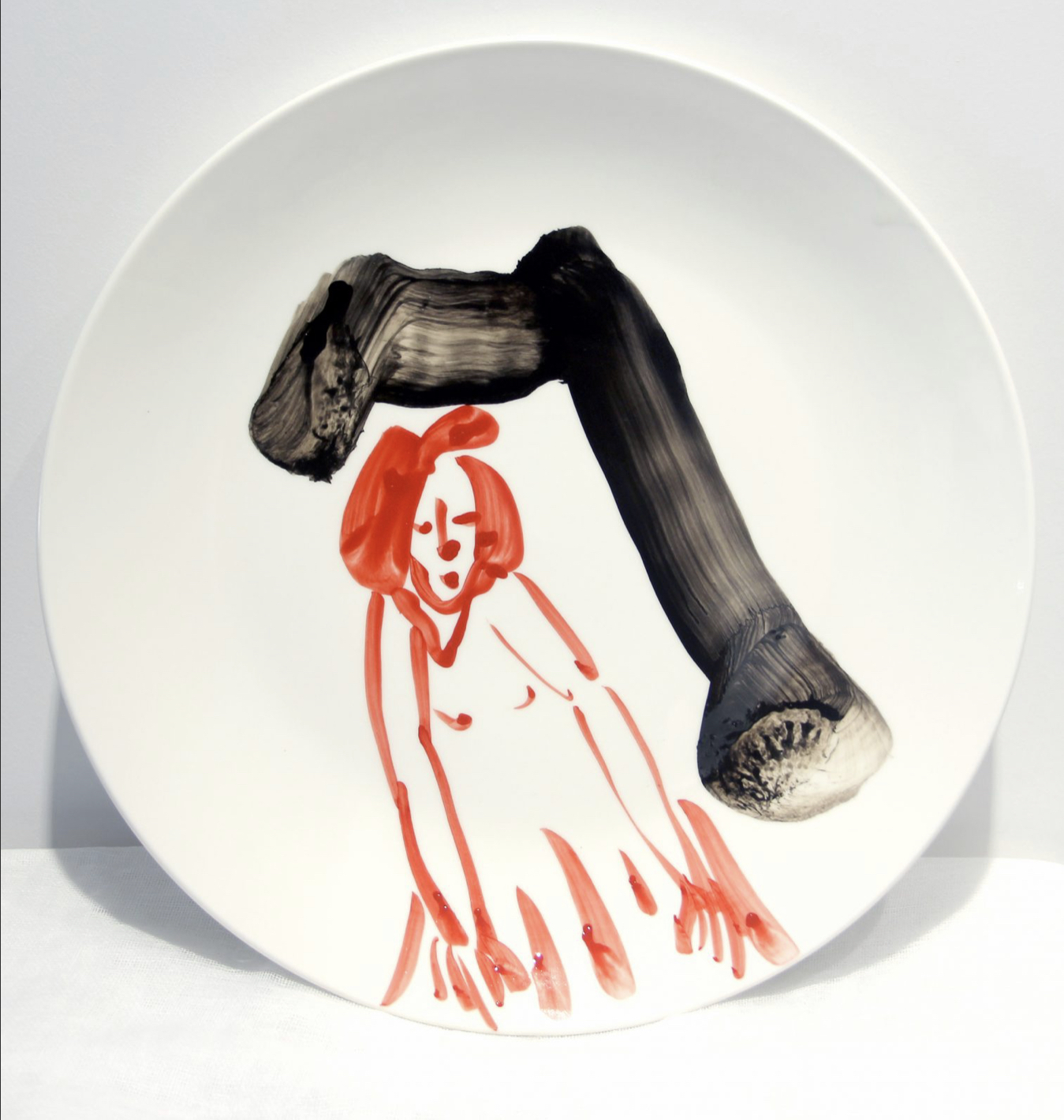
第二件重要事情就是我从抽象进入了人物。我从中国出来时候因为想把哲学把禅宗、道家,把西方德国的辩正主义哲学结合到我的艺术里面,我自己一直在思考,我怎么样画画。因此我开始琢磨自己的感觉,我想改变我自己的风格,所以那个时候我画抽象。九十年代末的时候,那个时候在德国及欧洲的一些大型美术馆和中国有我做过很多大型的展览后来突然觉得我可以改变了,我从抽象再回到我的人物表现的时候,那个时候我的创作非常的自由,非常的狂放。
The second major point was my shift from abstract art to figurative art. I have always longed to fuse Zen, Taoism and German dialecticism into my artwork. I had been thinking about the way I paint, the feelings I have when I paint and the changing of my style, so I did abstract paintings. At the end of 90s, after being exhibited in many major art museums in China and Germany, I felt that it was time for a change. Thus, my art-making became very free and wild when I changed from abstract to figurative work.

新表现主义对我的影响,从把自己完全的解放,抽象的解放,最后又回到一个抽象的人物,这是个非常重要的一个事情,那个时候在九十年代末就慢慢地开始从全抽象就又回到学院派技术的人物上。后来我觉得我自己的作品开始有所不同,我就可以更加自信地把自己的感觉放进去,把自己的情操放进去,因此自己的风格也逐渐形成。因此在那个时候就慢慢地有欧洲艺术评论家称我是九十年代末在德国是一个小有名气的,拥有个人风格的抽象画新表现主义的一个艺术家。
Neo-expressionism has influenced me, freeing me from abstraction and leading me back to figurative painting. It has become a significant part of my art. I gradually changed from pure abstract style to figurative painting, incorporating academic techniques from the late 90s. Later, I noticed that my works appeared differently, meaning my own style was established confidently with more feelings and emotions added in. It was in the late 1990s in Germany when some European critics called me a “rising neo-expressionist in abstract art with unique style”.
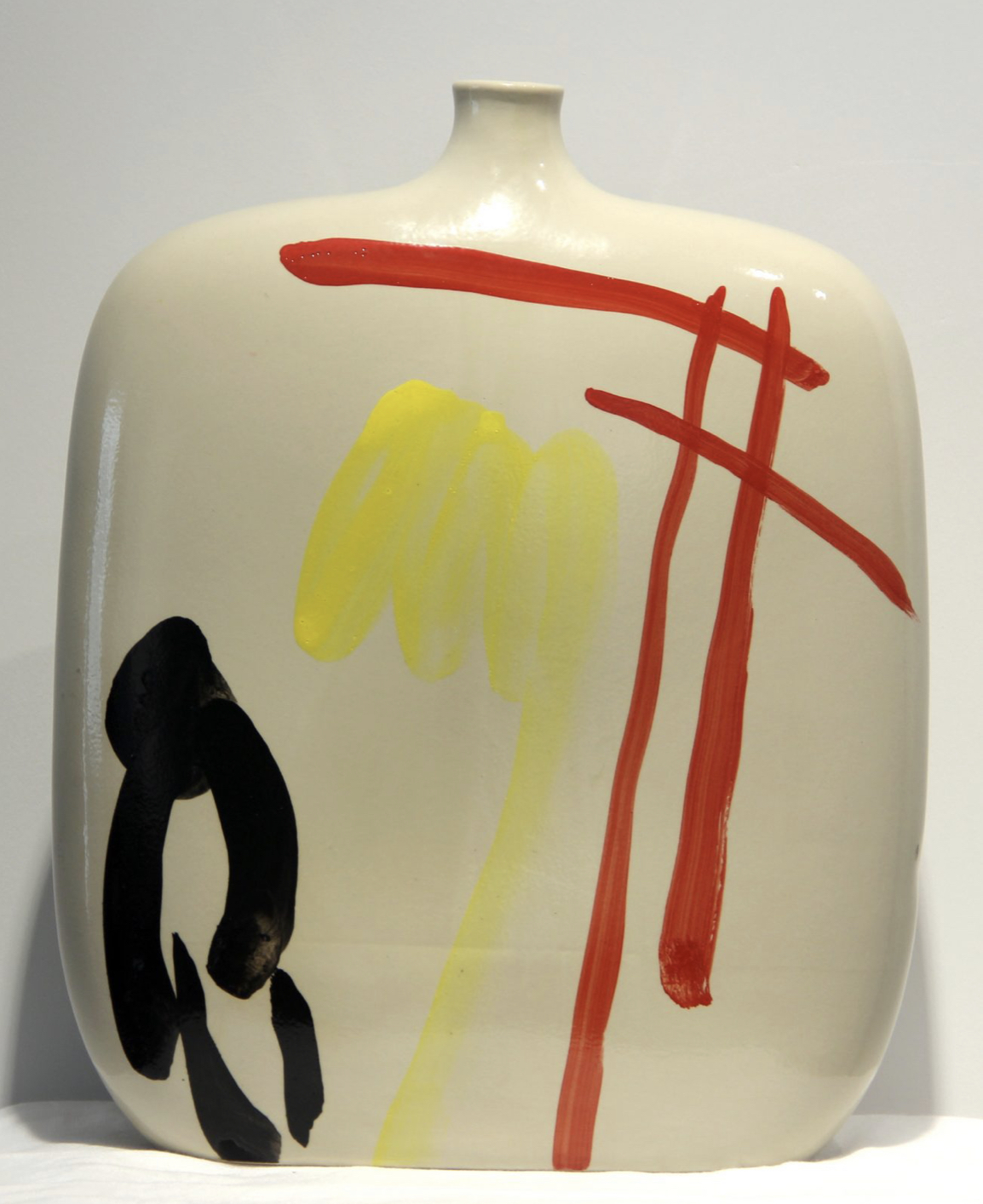
第三件重要事情就是我有一个非常长的一个做装置的时期,我从九十年代末一直到今天随着我的绘画我都一直在做我的装置。我参加很多重要的展览也都有的绘画也有我的装置包括的个人的展览。所以我的装置,在某种意义上也突出的代表了我的风格。一个艺术家,一个画家,他不仅绘画,它从各方面多元素的表现自己的风格,用各种不同的艺术语言去反映自己的整体的面貌。当今世界很多知名的艺术家。他们都不仅在绘画,不仅做雕塑,他们都拥有一个多元的艺术表现方式,因为艺术发展的二十一世纪以后人进入一个非常集中的,一个非常类型的一个时代。所以这个类型的时代促使了我完全的投入这个造型和表现,造型就是除了绘画还有装置。那除了装置还有摄影啊,还有多媒体等等。这些各个方面都形成了我作为在当今二十一世纪的一个艺术表现的全部含义,所以我觉得成为一个艺术家。他是要经过许许多多的过程,这个锤炼的过程就是一个自己革命的过程,一个自我反省的过程。
The third important thing was my long working period during which I made art installations. This started from the late 90s alongside my paintings and continues today. I participated in many art exhibition with both my paintings and installations, from group shows to solo shows. Those installations stand for my own style to a major extent. An artist should not only do paintings, but also should use various artistic elements to express his styles, showing a comprehensive artistic consideration with diversified art languages. Many famous artists today use diverse artistic media, varying from paintings to sculptures and to a wider range of styles. Art develops into an intensively diversified portfolio of forms. This has encouraged me to devote my time to creating paintings, installations, photography and multi-media arts, which all formed my contemporary artistic expression in the 21st century as a whole. I think, as an artist, the process of changing and transforming artistic styles is also a process of self-revolution and self-introspection.
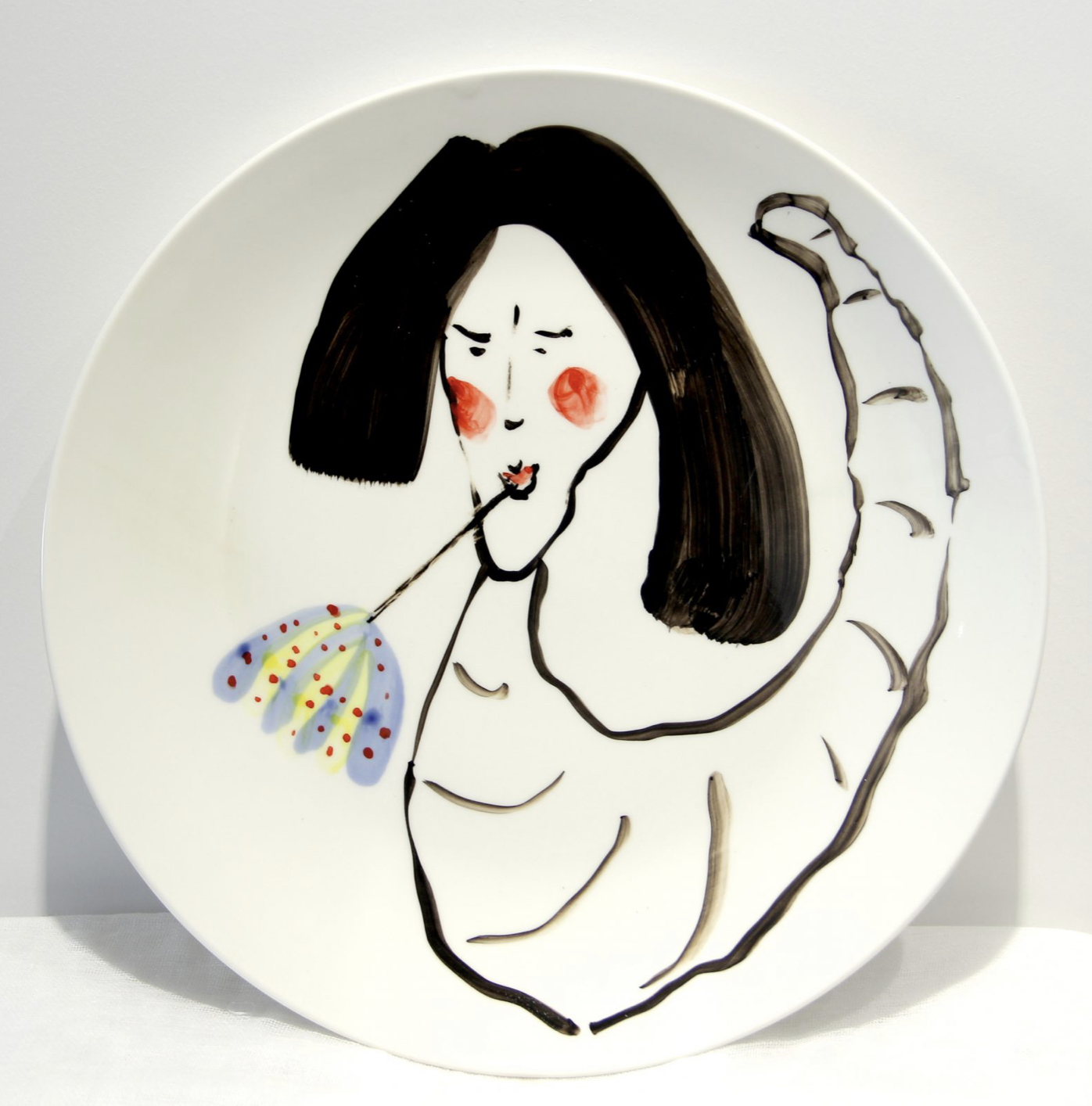
第四个重要事情就是我成为德国新表现主义艺术家以后把我自己的个人的艺术水准推到一个非常重要的一个高度,从2002年至今十五年的时间里,我参加了很多国际上的有非常重量级的艺术展览,我作为一个代表性艺术家能加入了这个行列对我个人来说是个非常重要的一个鼓励。我作为一个艺术家能够在西方能够在德国站住脚,而且能够把自己风格能够宣传和表现出去。所以这是个非常非常重要的一个阶段,这个感觉对我来说非常重要。因为这个感觉就更加的自信。作为一个艺术家就是要自信,必须要骄傲,否则这个人的艺术就非常非常的胆怯,所以通过把自己这个推出去,把自己能够放到一个比较高的位置上去。就能够跟国际上的艺术家比肩,做一些国际性的重要的展览。这都是非常非常重要的,对于任何一个艺术家来说,这都是一个鞭策。
The forth important thing has been to raise the quality of my art to new heights after being declared a German neo-expressionist. For fifteen years since 2002, I have participated in many major art exhibitions throughout the world, which has been a great encouragement for me to continue creating art. Being a recognized artist in the West, I am able to promote and express my own art style. This experience has been exceptional to me, giving me great confidence in my artistic life. An artist is meant to be confident and proud, otherwise his art will show timidity. I was able to advocate for myself and push my art to a higher level, to be compared with international artists and to join important exhibitions, which would be hugely encouraging for any artist.

我离开中国三十年了,所以中国发生什么事情我就像一个外国人一样去听一听看一看,看看媒体如何报道,我也从来不打关心政治,所以这些重要大事对我来说没有什么关系。
I left China thirty years ago, thus I always look at issues happening in China with a foreigner’s perspective. Looking at the media’s presentations, I don’t really care about politics; those major political issues seem irrelevant to me.
在欧洲或者世界上其它地方发生的事情,即便是一个社会发展潮流。一个艺术家他始终是站在自己的角度和立场来看待这个世界,他不会为这个世界发生一些左右,除非是一个战争或者类似事件。我认为在欧洲这么和平的环境下,尽管有这样那样的事情,但是老百姓的生活和整个欧洲社会和文化的大环境,一个包括文化和修养的机遇,对于一个艺术家的发展没有很大的干扰。
Issues in Europe or other parts of the world, or even social development topics, are to an artist objective matters which he should be looking at with his own angle and position. He should not be swayed by the issues, unless there are wars or similar chaos. I think in a peaceful environment in Europe, people’s life and society, as well as the broader culture and cultivation opportunities are not vastly influential in an artist’s development.

最后这个问题我为什么选择我当前的手法这个问题提出的有点荒谬,一个艺术家的成功,他不是选择这种艺术手法。是这个艺术这个风格在经过一个艺术家一生的一个锤炼以后。他产生了这个艺术风格,不是说我选择了这个风格去做我的艺术。我表现我的艺术是用我的心灵,用我的血肉。用我的精神用我的个人的整体的灵魂去表现这个艺术的。所以这和一个艺术家他的独立性是有关系的,因为任何艺术家他都不需要听别人去说,你应该怎么他应该怎么。一个艺术家的本体,他是一个世界,他是个独立的世界,这个世界要去影响更多的世界。这个独立的世界是最重要的,所以我不需要去选择什么我就做我想做的,这个就是我的艺术的立场。
Any interview question asking about my choice of style and technique appears a bit absurd. A successful artist does not choose his style or technique, but forms the style after a life-long exploration of his artistic development. He forms this style, instead of choosing it, to create art. I express my art with heart and flesh, with my spirit and whole soul. It’s a matter of independence for an artist; he needs not to listen to others’ opinions. An artist is in a world of his own, thus he could influence the outside world as a whole. I have not chosen a style.
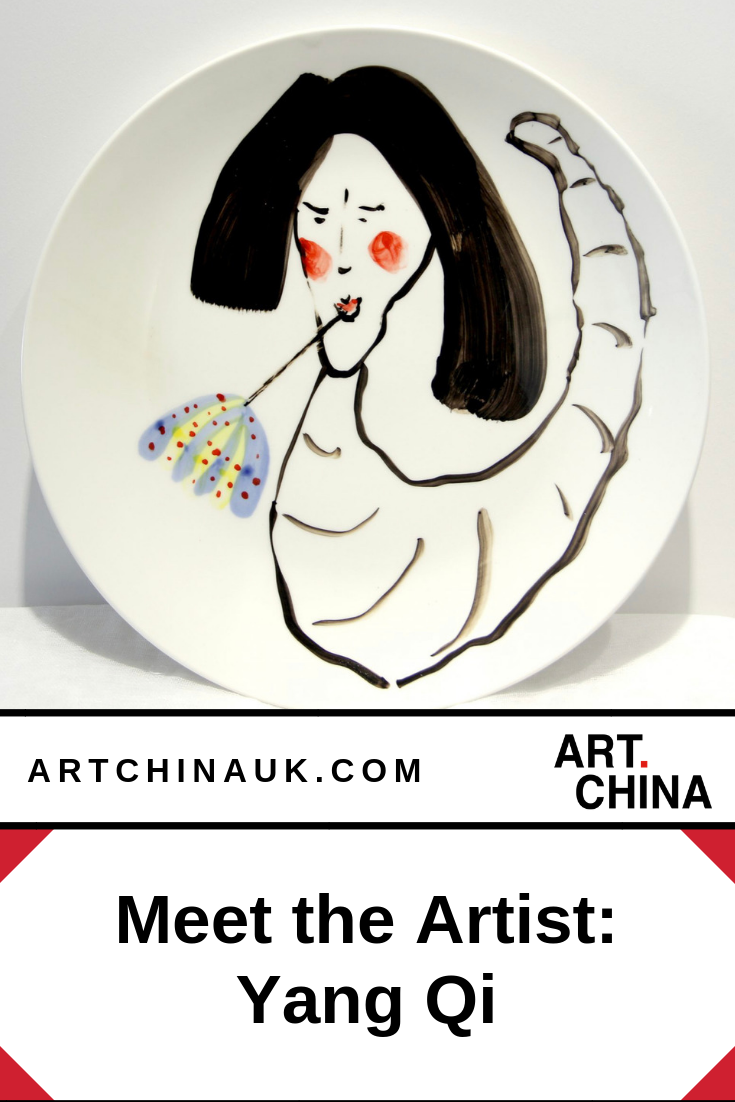
这个采访不是在作秀采访就是要说真话,就是向新闻媒体是说出一个艺术家的他想说的事情,其他都不是我的事情。因为我只对我自己负责,我对我的艺术负责,这个至于别人去怎么样欣赏我的艺术去夸奖我的艺术或者去批评我的艺术,这都是很自然的事情。
This interview should not be a show, thus I want to express what is true to me, saying what I want to say to the media. Other things are not related to me. I am responsible to my own art, and to myself. How people praise or criticise my art should be a very natural thing.





 I felt Iprivileged to share the artist’s spiritual journey of their creation.’Church in Assisi’ is the temple of his art. He offers his devotion, his compassion, enduring on his artistic journey. He shared his answer, ‘What is an artist?’ with the world.
I felt Iprivileged to share the artist’s spiritual journey of their creation.’Church in Assisi’ is the temple of his art. He offers his devotion, his compassion, enduring on his artistic journey. He shared his answer, ‘What is an artist?’ with the world.




 Alone is not lonely 2020, Acrylic-on-canvas, 100cmx80cm
Alone is not lonely 2020, Acrylic-on-canvas, 100cmx80cm Get together, 2020 Acrylic on canvas 100cmx80cm
Get together, 2020 Acrylic on canvas 100cmx80cm One night story, 2020 Acrylic on canvas 100cmx80cm
One night story, 2020 Acrylic on canvas 100cmx80cm Magic boy, 2020 Acrylic on canvas 100cmx80cm
Magic boy, 2020 Acrylic on canvas 100cmx80cm The artist as Hermit 2004-19 oil and acryl on canvas 160 cm x 120 cm
The artist as Hermit 2004-19 oil and acryl on canvas 160 cm x 120 cm The artist as Hermit 2004-19 oil and acryl on canvas 160 cm x 120 cm
The artist as Hermit 2004-19 oil and acryl on canvas 160 cm x 120 cm The artist as Hermit 2004-19 oil and acryl on canvas 160 cm x 120 cm
The artist as Hermit 2004-19 oil and acryl on canvas 160 cm x 120 cm The artist as Hermit 2004-19 oil and acryl on canvas 160 cm x 120 cm
The artist as Hermit 2004-19 oil and acryl on canvas 160 cm x 120 cm A man with lotus, 2018 Acrylic on canvas 210cmx160cm
A man with lotus, 2018 Acrylic on canvas 210cmx160cm Together, 2020 Acrylic on canvas 100cmx80cm
Together, 2020 Acrylic on canvas 100cmx80cm Angelika, 2019 Acrylic on canvas 120cmx100cm
Angelika, 2019 Acrylic on canvas 120cmx100cm Theater, 2020 Acrylic on canvas 100cmx80cm.
Theater, 2020 Acrylic on canvas 100cmx80cm. Monika, 2019 Acrylic on canvas 120cmx100cm
Monika, 2019 Acrylic on canvas 120cmx100cm Venus and her friends, 2018 Acrylic on canvas 210cmx160cm
Venus and her friends, 2018 Acrylic on canvas 210cmx160cm Illusion 2018 Acrylic on canvas 210cmx160cm
Illusion 2018 Acrylic on canvas 210cmx160cm Where you are from, 2020 Acrylic on canvas 100cmx80cm.
Where you are from, 2020 Acrylic on canvas 100cmx80cm. A friend Indeed, 2018 Acrylic on canvas 210cmx160cm.
A friend Indeed, 2018 Acrylic on canvas 210cmx160cm. We love art, 2020 Acrylic on canvas 100cmx80cm.
We love art, 2020 Acrylic on canvas 100cmx80cm.

















